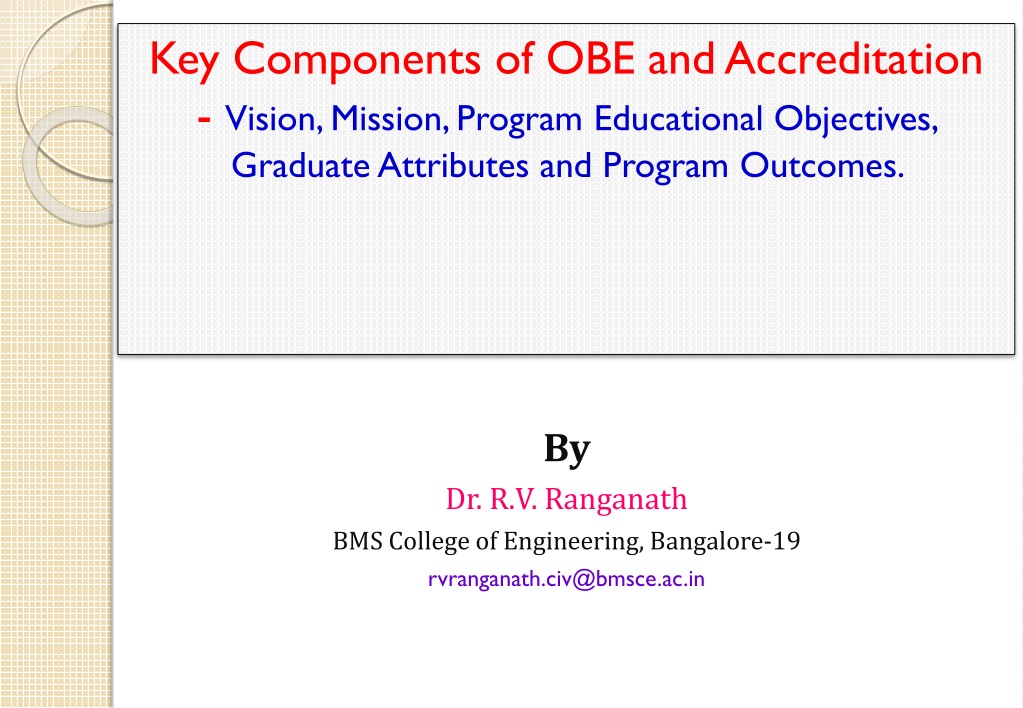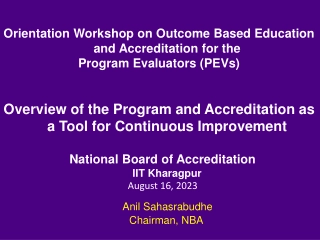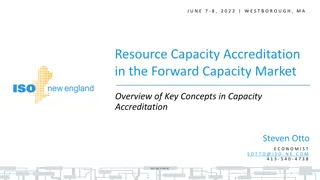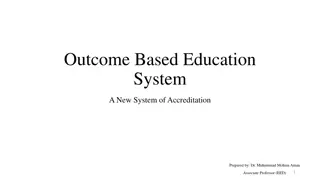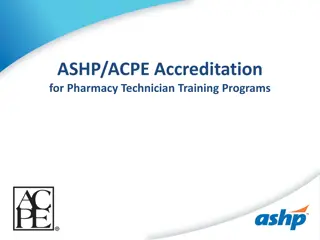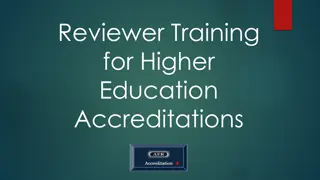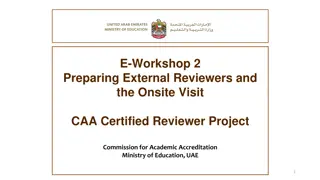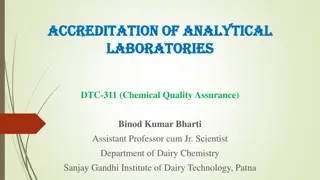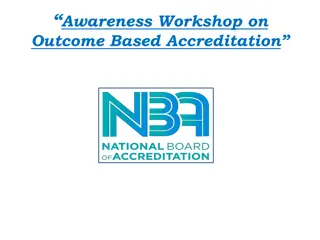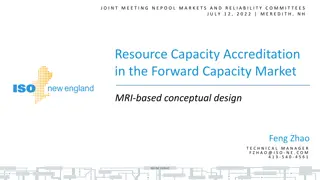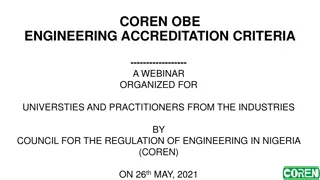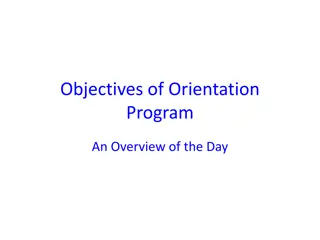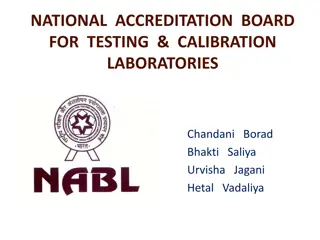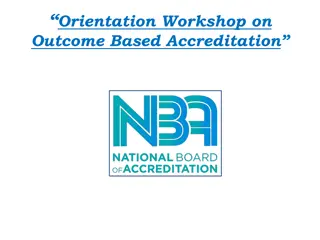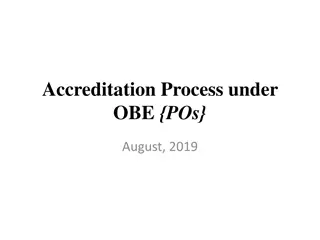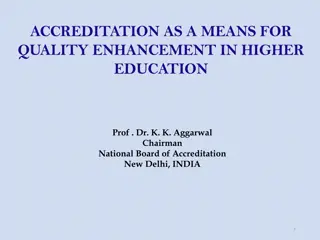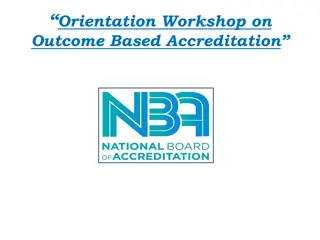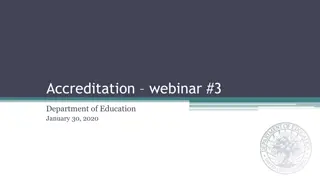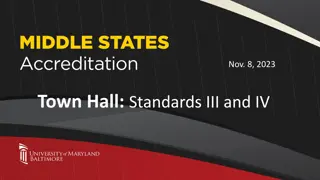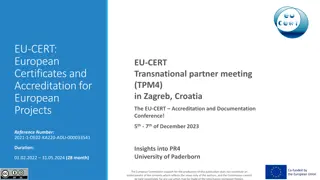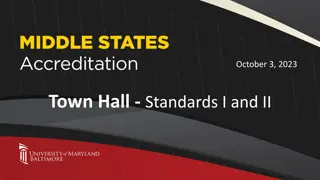Understanding Outcome-Based Education and Accreditation in Higher Education
Outcome-Based Education (OBE) is a process that focuses on high-order learning and mastery rather than course credits accumulation. Globalization has shifted education towards building learner competencies for the rapidly changing workplace. This framework emphasizes Vision, Mission, Program Educational Objectives, Graduate Attributes, and Program Outcomes to ensure quality education and accreditation. Criteria for accreditation in OBE include academic support units, teaching-learning processes, governance, student performance, faculty contributions, and continuous improvement. Implementation involves administrative roles such as course coordinators, module coordinators, program coordinators, and quality assurance cells. Vision and mission statements play a crucial role in defining institutional aspirations and objectives.
Download Presentation

Please find below an Image/Link to download the presentation.
The content on the website is provided AS IS for your information and personal use only. It may not be sold, licensed, or shared on other websites without obtaining consent from the author. Download presentation by click this link. If you encounter any issues during the download, it is possible that the publisher has removed the file from their server.
E N D
Presentation Transcript
Key Components of OBE and Accreditation - Vision, Mission, Program Educational Objectives, Graduate Attributes and Program Outcomes. By Dr. R.V. Ranganath BMS College of Engineering, Bangalore-19 rvranganath.civ@bmsce.ac.in
Outcomes Based Education Outcomes based education (OBE) is a process that involves the restructuring of curriculum, assessment and reporting practices in education to reflect the achievement of high order learning and mastery rather than the accumulation of course credits (Tucker, 2004). (http://www.slideshare.net/jellai09/obe-approaches?from_action=save)
Why Outcome Based Accreditation Globalization has brought in a clear shift from education as transmission of expert knowledge to education as building learner competencies including learning to learn and life long learning. That means focus will have to be on Understanding fundamentals very well, and learning new skills/competencies that would enable individuals to cope with the demands of the rapidly changing workplace. Prepare global engineers who will have to solve problems and shoulder challenges which are not even known today!!
Accreditation Criteria (OBE) Academic Support Units and Teaching-learning Process Vision, Mission and PEOs Programme Outcomes Governance, Institutional Support and Financial Resources Programme Curriculum Student Performance Faculty Contributions Continuous Improvement Facilities and Technical Support
Outcome Based Education for Outcome Based Accreditation (Education) (Curriculum) (Learning & Teaching) (Assessment)
The OBE Framework PO CO
Administrative System for Implementation of OBE Course Coordinator Module Coordinator Programme Coordinator Programme Assessment Committee Department Advisory Board Internal Quality Assurance Cell (IQAC)
Vision and Mission Statements Statements help in defining aspirations and to remain focused Should be written in a simple language, easy to communicate and should define objectives which present near future of the Institute Vision statement is dream of where one wants the Institute to be and inspires all the stake holders Mission statements are actionable statements that guide the stake holders to act
How to formulate Vision and Mission Statements Bottoms up approach Involve all stakeholders Discussion, Brain storming Gap analysis or SWOT analysis Challenges before the institute What are the immediate and long term goals Evolve Vision and Mission statements based on these discussions Strategic plan
Vision and Mission Statements (as per NBA document) Vision is a futuristic statement that the institution would like to achieve over a long period of time, and Mission is the means by which it proposes to move toward the stated Vision Example.. Vision: To emerge as one of the nation s finest Institutions in the field of Technical Education and Research through focused, effective and sustained monitoring of its programmes and resources. Mission: To develop high quality professionals ingrained in ethics, wisdom and creativity for the betterment of the society.
Corrected Vision and Mission Statements Vision:. To emerge as one of the nation s finest Institutions of higher learning in the field of Technical Education to develop professionals who are technically competent, ethical, environment friendly for betterment of society. Mission: Accomplish stimulating learning environment for students through quality teaching, research and outreach activity by providing state of the art facilities, industry exposure and guidance of dedicated faculty
Department Vision and Mission Statements (Sample) Vision: To be an excellent centre for imparting quality higher education in Civil Engineering for a constantly changing societal needs with credibility, integrity and ethical standards. Mission: Accomplish excellence in curricular, co-curricular activities with a committed faculty through teaching and research which creates technically competent and dedicated civil engineers to serve their surroundings with pride.
Program Educational Objective-PEO The educational objectives of an engineering degree program are the statements that describe the expected achievements of graduates in their career, and also in particular, what the graduates are expected to perform and achieve during the first few years after graduation. The PEOs, may be guided by global and local needs, vision of the Institution, long term goals etc. For defining the PEOs the faculty members of the program must continuously work with all Stakeholders: Local Employers, Industry, Students and the Alumni
PEOs (Samples) PEO1: Graduate will compete on a global platform to pursue their professional career in Electrical Engineering and allied disciplines. PEO2: Graduates will pursue higher education and/or engage in continuous up gradation of their professional skills. PEO3: Graduate will communicate effectively and will demonstrate professional behaviour while working in diverse team. PEO4: Graduates will demonstrate concern for society and environment.
(Samples 2 - Civil Engineering) PEO1: Practice civil engineering in construction industry, public sector undertaking and as an entrepreneur for successful professional career. PEO2: Pursue higher education for professional development PEO3: Exhibit leadership qualities with demonstrable attributes in lifelong learning to contribute to the societal needs.
Processes for PEOs Feedback format for collecting data from stakeholders A process by which PEOs are created and reviewed periodically A process to evaluate to what extent PEOs are attained Review, Mid correction, and Continuous Quality Improvement
Program Outcomes POs are statements about the knowledge, skills and attitudes (attributes) the graduate of a formal engineering program should have. Profile of the Graduates reached through POs - Target POs are defined Agencies of the country (NBA in India) Defining these is the Starting Point by Accreditation
Program Outcomes (POs) 1. Engineering Knowledge: Apply the knowledge of mathematics, science, engineering fundamentals, and an engineering specialization to the solution of complex engineering problems. 2. Problem Analysis: Identify, formulate, review research literature, and analyze complex engineering problems reaching substantiated conclusions using first principles of mathematics, natural sciences, and engineering sciences. 3. Design/Development of Solutions: Design solutions for complex engineering problems and design system components or processes that meet the specified needs with appropriate consideration for the public health and safety, and the cultural, societal, and environmental considerations 4. Conduct Investigations of Complex Problems: Use research-based knowledge and research methods including design of experiments, analysis and interpretation of data, and synthesis of the information to provide valid conclusions.
Conti 5. Modern Tool Usage: Create, select, and apply appropriate techniques, resources, and modern engineering and IT tools including prediction and modeling to complex engineering activities with an understanding of the limitations. 6. The Engineer and Society: Apply reasoning informed by the contextual knowledge to assess societal, health, safety, legal and cultural issues and the consequent responsibilities relevant to the professional engineering practice. 7. Environment and Sustainability: Understand the impact of the professional engineering solutions in societal and environmental contexts, and demonstrate the knowledge of, and need for sustainable development. 8. Ethics: Apply ethical principles and commit to professional ethics and responsibilities and norms of the engineering practice.
Conti Individual and Team Work: Function effectively as an individual, and as a member or leader in diverse teams, and in multidisciplinary settings. 10. Communication: Communicate engineering activities with the engineering community and with society at large, such as, being able to comprehend and write effective reports and design documentation, make effective presentations, and give and receive clear instructions. 11. Project Management and Finance: Demonstrate knowledge and understanding of the engineering and management principles and apply these to one s own work, as a member and leader in a team, to manage projects and in multidisciplinary environments. 12. Life-long Learning: Recognize the need for, and have the preparation and ability to engage in independent and lifelong learning in the broadest context of technological change. 9. effectively on complex
PROGRAM SPECIFIC OUTCOMES (PSO) These outcomes are specific to a program in addition to NBA defined POs, namely, Civil, Mechanical, Chemical, Computer science etc.,(2-4) Example: Civil Engineering can have PSOs as: PSO1: Able to analyse and design building structural systems. PSO2: Able to provide design solutions to water supply and sewage systems. PSO3: Able to identify and analyse transportation engineering problems and provide solutions for the benefit of society.
Why the NBA's POs are What they are? Source: NBA learning resources
WA - Graduate Attributes and NBA- Program Outcomes Washington Accord Attributes NBA Program Outcomes. !.Engineering knowledge, Apply the knowledge of mathematics, science, engineering fundamentals, and engg. specialization to the solution of complex engineering problems !.Engineering knowledge, Apply knowledge of mathematics, science, engineering fundamentals and an engineering specialization to the solution of complex engineering problems. 2. Problem Analysis, Identify, formulate, research literature and analyze complex engineering problems reaching substantiated conclusions using first principles of mathematics, natural sciences and engineering sciences 2. Problem Analysis, Identify, formulate, research literature, and analyze engineering problems to arrive at substantiated conclusions using first principles of mathematics, natural, and engineering sciences. Source: NBA learning resources
PO 1-5 POl. Engineering knowledge: Apply the knowledge of mathematics, science, engineering fundamentals, and engineering. specialization to the solution of complex engineering problems. PO2. Problem analysis: Identify, formulate, review research literature, and analyze complex engineering problems reaching substantiated conclusions using first principles of mathematics, natural sciences, and engineering sciences. PO 3 Design/development of solutions: Design solutions for complex engineering problems and design system components, processes to meet the specifications with consideration for the public health and safety, and the cultural, societal, and environmental considerations. Conduct Investigations of Complex Problems: Use research-based knowledge and research methods including design of experiments, analysis and interpretation of data, and synthesis of the information to provide valid conclusions. Modern Tool Usage: Create, select, and apply appropriate techniques, resources, and modern engineering and IT tools including prediction and modeling to complex engineering activities with an understanding of the limitations.
Why place these POs in one Basket? The Statements show that one part {That of (complex) Engineering Problem CEP} is common to all. Though, individually each PO deals with a different aspect of CEP. Recognizing this commonality makes the discussion easier. Source: NBA learning resources
Complex Engineering Problem-CEP 1. Problems not the kind generally encountered at the ends of text book chapters. (These often test if the contents of the chapter have been understood) 2. These are problems that have not been completely framed and leave at least a few* choices for the student to make. 3. Problems may require use of laws of physics, or bring in some mathematical tools in which the problem can be framed.
Course Outcomes (COs) Statements of observable student actions that serve as evidence of the Knowledge, Skills and Attitudes acquired in a course . Each course is designed to meet (about 6) Course Outcomes The Course Outcomes are stated in such a way that they can be actually measured. POs are attained through program specific Core Courses
Course Outcomes Engineering Physics (Not a Good Example) CO1: Understand the knowledge of basic quantum mechanics, to set up one-dimensional Schrodinger s wave equations and its application to few physical problems. CO2: Understand the fundamental aspects of crystallography, able to recognize various planes in a crystal and have knowledge of structure determination using x-rays. CO3: Understand the role of free electrons in determining the properties of metals, the concept of Fermi energy, and the domain formation in ferromagnetic materials. CO4: Understand the basic laser physics, working of lasers, holography and principle of propagation of light in optical fibers. CO5: Understand the theory of free, damped and forced vibrations of a particle and also the concept of resonance and its applications in ESR & NMR. What level of BLOOM,s Taxonomy you want your students to achieve?
Comparison Program Outcomes Bloom s Levels Remember (K1) Understand (K2) Engineering Knowledge: Apply the knowledge of mathematics, science, engineering fundamentals, and an engineering specialization to the solution of complex engineering problems Apply Knowledge Apply (K3) Problem Analysis: Identify, formulate, review research literature, and analyze complex engineering problems reaching substantiated conclusions using first principles of mathematics, natural sciences, and engineering sciences Analyze (K4)Problem Analysis Design/Development of Solutions: Design solutions for complex engineering problems and design system components or processes that meet the specified needs with appropriate consideration for the public health and safety, and the cultural, societal, and environmental considerations. Design/Develop ment of Solutions Evaluate (K5)
Structure of Course Outcomes: Course Outcome statement may be broken down into two main components: An action word that identifies the performance to be demonstrated; Learning statement that specifies what learning will be demonstrated in the performance; Examples of good action words to include in course outcome statements: Compile, identify, create, plan, revise, analyze, design, select, utilize, apply, demonstrate, prepare, use, compute, discuss, predict, assess, compare, rate, critique, outline, or evaluate
Course Title: Strength of Materials Course Outcomes: Example At the end of the course, student is able to: Action Verb 1. Apply laws of physics (eg..Hook s law, etc.,) to compute different types of response (stress and deformation) in the given materials. (PO 1) Learning Statement 2. Analyse structural elements for different force systems to compute design parameters (BM and SF) (PO2) 3. Design compression elements using engineering principles to resist any given loads. (PO3) 4. Conduct experiments to validate physical behaviour of materials/components.(PO4) 5. Prepare laboratory reports on interpretation of experimental results (P10)
Assessment: It is one or more processes that identify, collect, and prepare data to evaluate the achievement of Course Outcomes and Program Outcomes PO/Course Assessment Tool Types PO/ Course Assessment Tool Tests 1 2 3 4 5 6 7 8 9 10 11 12 Assignments Direct Tools Lab/Seminars/Industri al Training/ Projects (Rubrics) Course End Survey Exit Survey Faculty Survey Indirect Tools Alumni Survey Programme Statistics
CO-PO Relationship Each CO can be identified to address a subset of POs Based on the number of COs and the sessions dedicated to them it is possible to identify the strength of mapping (1, 2 or 3) to POs Based on these strengths of selected POs a CO matrix can be established.
CO-PO Relationship COURSE COs CO1 CO2 CO1 CO2 CO3 CO1 CO2 CO3 CO4 CO1 CO2 CO3 CO4 CO1 CO2 CO3 CO1 CO2 CO3 CO4 CO1 CO2 CO3 CO4 CO1 CO2 CO3 CO4 PO1 3 3 3 3 - 3 3 3 3 3 - - - 3 3 3 3 3 3 2 3 PO2 3 3 2 3 - 3 3 3 3 - 3 3 - 3 3 3 3 3 3 3 - 3 - PO3 - - - - 3 - - - 2 - 3 3 - - - 3 - - - 2 - - - 3 - 3 - - PO4 - - 3 - - - - - - - - - - - - - 1 - - - - PO5 - - - - - - - - - - - - - - - - - 2 - - - - PO6 - - 3 3 - - - - 3 - - - - - - - - 2 - 3 - - - - - - - - PO7 - - 3 3 3 - - - - - - - - - - - - - - - 3 3 3 2 3 - - - PO8 - - - - 3 - - - - - - - 3 - - 3 - - - - PO9 - - - - - - - - - - - - 3 - - - - - - - - - - - 3 3 3 3 PO10 - - - 3 3 - - - - - - - - - - - - - - - - - - - - - - 3 PO11 - - - - - - - - - - - - - - - - - - - - - - - - - - - 2 PO12 - - - - - - - - - - - - - - - - - - - - 1 3 2 - - 3 - - Analysis of structures II Environmental Engineering I Geotechnical Engineering II Concrete Technology Hydrology and water resources Quantity Surveying and Costing Alternate Building Material & Technology - - - 3 - - 2 - - 3 - 3 - 3 - - - 3 - - - 3 - - Major Project Phase II
Alignment of Assessment to COs and hence to POs Example.
Course:- Concrete Technology Example-1 Topic: Mix Proportioning Mix proportioning is a process of arriving at suitable proportions of concrete ingredients based on their characteristics to achieve desired strength and durability characteristics of concrete. Here, students will have the freedom of selecting different types of cements, aggregates, admixtures to arrive at a given grade of concrete say M40.
Contd., To introduce complexity, students can be asked to provide solutions for the same M40 grade concrete but to be used in different field conditions such as Hot weather concreting, Underwater concreting, Mass concreting, High early strength requirement in say 3 days.
PO1:Engineering Knowledge: Apply the knowledge of mathematics, science, engineering fundamentals, and an engineering specialization to the solution of complex engineering problems Example Situation 1: CO3: Able to understand mix proportioning techniques for field applications. Assessment for CO3: (Question in Tests) Briefly explain the various methods of mix proportioning techniques. Does this CO reflects the intended measurement from PO1? Does the assessment correlates well with the CO? Mapping: CO3- PO1.
In this case, CO does not reflect the intention of measuring application of either science, maths or engineering principles. It can measure only remembrance in this topic. Further, the assessment, does not test the requirement of application of engineering principles used in mix proportioning as per PO1. Hence, the correlation between CO-PO is weak.
PO2:Problem Analysis: Identify, formulate, review research literature, and analyze complex engineering problems reaching substantiated conclusions using first principles of mathematics, natural sciences, and engineering sciences. Example Situation 2: CO3: Able to apply mix proportion principles to design a concrete mix for field applications. Assessment for CO3: (Question in Tests) Proportion a concrete mix for M40 grade concrete by IS method. Given data: maximum nominal size of aggregate: 20mm; minimum cement content: 340kg/cum; maximum w/c ratio: 0.45; workability: 75mm slump; exposure: very severe; concreting type: pumping mode; quality at site: good; aggregate type: sub-angular; sp. gr of cement 3.15, aggregate 2.68, flyash 2.08, SP 1.08, Design using IS 10026 2009. Is CO reflects the intended measurement from PO2? Does the assessment correlates well with the CO? Mapping: CO3 - PO2
In this case, the assessment does not test the students ability to identify, formulate and do some research for arriving at a suitable concrete mix for a given situation since many variables of the design have already been identified in the problem and hence the strength of mapping of CO3 for PO2 in the above example can not be considered good. At best it can map well for PO1 as it involves application of engineering fundamentals.
PO3: Design/Development of Solutions: Design solutions for complex engineering problems and design system components or processes that meet the specified needs with appropriate consideration for the public health and safety, and the cultural, societal, and environmental considerations. Example Situation 3: CO3: Able to analyse characteristics of mix constituents and design a concrete mix for field applications. Assessment:/ASIGNMENT/ ABC Construction Company is entrusted with manufacturing of precast elements for elevated express way. The precast elements are required to attain 40 MPa in 7 days. Design a mix for least cost. The mix should comply with the requirements of IS 10262 and IS 456. Is CO reflects the intended measurement from PO2, PO3 ? Does the assessment correlates well with the CO? Remarks: CO3 PO2, PO3
Contd In this case, students are expected to identify and formulate various design parameters such as type of cement which can be used for early strength gain, water content (W/C), workability required to manufacture such precast elements. They are also required to look for specifications as per the codal provisions and then apply engineering principles to arrive at mix proportions for a least cost. The assessment correlates well with the CO and hence maps strongly for PO2 and PO3.
COs (Summary) Example Situation 1: Able to understand mix proportioning techniques for field applications. Example Situation 2: Able to apply mix proportion principles to design a concrete mix for field applications. Example Situation 3: Able to analyse characteristics of mix constituents and design a concrete mix for field applications. (Choice of writing an appropriate CO and choosing the right assessment to map corresponding PO remains with the course instructor)
Example of CO-attainment for a course Course Name :Concrete Technology Course Code :CV 41 Session of Course Batch-2013, Sep-Dec'2013 L : T : P - Semester : Credits : Batch : Faculty :R V Ranganath Grading Scale SCORE : < 50% 50% - < 70% 1 2 3 50% I 4 > =70% 70% 2013 Percent of Students should score > 70% of marks for Attainment 75% CO CO Decription T1 T2 A1 A2 LAB Identify constituent of concrete material characteristics different types of concrete for their appropriate use in construction. [K 2](PO1) and CO1 - - - - Q1.a, b, Q2 a,b Compare concrete known materials for design applications(PO2, PO3) behaviour properties of with CO2 A1 - - - Analyse characteristics of mix constituents and concrete mix applications. { PO2, PO3) Prepare a report on new knowledge in any one of the topic related to concrete technology [K5] (PO8, PO9) design for a A2 - CO3 - - field Q1, Q2 comprehensive CO4 - - lab-
Example of CO-attainment for a course Program Outcomes PO1 Max Marks 10 10 10 10 40 5 5 SCORES OR GRADING SCORES OR GRADING BASED ON SCALE OF 3 BASED ON SCALE OF 3 TOTAL MARKS ATTEMPTED TOTAL MARKS ATTEMPTED Target > =70% Target > =70% PERCENT, % PERCENT, % Course Outcomes CO1 CO2 TOTAL OBTAINED TOTAL OBTAINED Assignment- 1 USN Name T1-Q1.a T1-Q1.b T1-Q2.a T1-Q2.b 1BM13CCT01 ANUSHA S. B. 23 30 77% 3 Y 3 5 60.00% 2 3 8 7 8 1BM13CCT02 BHAVISH DAS (discontinued after I sem) 31 40 78% 3 Y 4 5 80.00% 3 Y 4 5 6 12 8 100.00 % 1BM13CCT03 DEEPA M NAIK 15 20 75% 3 Y 5 5 3 Y 5 8 7 1BM13CCT04 GOLLAPALLI NIRANJAN REDDY 16 20 80% 3 Y 4 5 80.00% 3 Y 4 9 7 1BM13CCT05 JHANSI RAMA PRIYA 18 20 90% 3 Y 4 5 80.00% 3 Y 4 9 9 1BM13CCT06 NIRANJANA N 25 40 63% 2 4 5 80.00% 3 Y 4 7 6 9 3 1BM13CCT07 PAVAN J. 18 20 90% 3 Y 4 5 80.00% 3 Y 4 9 9 1BM13CCT08 PRAMOD B. V. 19 20 95% 3 Y 3 5 60.00% 2 3 10 9 1BM13CCT09 PRAVEEN GONGACHI 11 20 55% 2 4 5 80.00% 3 Y 4 4 7 1BM13CCT10 RAJESH A. 16 20 80% 3 Y 4 5 80.00% 3 Y 4 9 7 1BM13CCT11 SALMAN PASHA 20 30 67% 2 4 5 80.00% 3 Y 4 7 7 6 1BM13CCT12 SHARATH R. 30 40 75% 3 Y 3 5 60.00% 2 3 7 7 8 8 1BM13CCT13 SHRINATH 17 20 85% 3 Y 4 5 80.00% 3 Y 4 9 8 1BM13CCT14 SOWMYA H. V. 16 20 80% 3 Y 4 5 80.00% 3 Y 4 9 7 1BM13CCT15 SUNIL KUMAR B. M. 16 30 53% 2 3 5 60.00% 2 3 2 7 7 1BM13CCT16 VIKAS PRABHAKAR ATTIGERI 17 20 85% 3 Y 4 5 80.00% 3 Y 4 9 8 1BM13CCT17 VIKRAM C GATEGAR 15 20 75% 3 Y 4 5 80.00% 3 Y 4 7 8 100.00 % 1BM13CCT18 VILASKUMAR S. LONIMATH 16 20 80% 3 Y 5 5 3 Y 5 8 8 SUM SUM 50 14 50 14 AVG GRADING AVG GRADING 2.78 2.78
Example of CO-attainment for a course 10 10 10 10 40 SCORES OR Target > =70% PERCENT, % SCALE OF 3 BASED ON GRADING ATTEMPTED OBTAINED CO3 MARKS TOTAL TOTAL T1-Q3.a T1-Q3.b T2-Q2.a T2-Q2.b 15 17 27 9 18 0 0 16 16 14 14 0 32 18 11 33 23 17 20 20 40 10 20 40 40 20 20 20 20 40 40 20 20 40 30 20 75.00% 85.00% 67.50% 90.00% 90.00% 0.00% 0.00% 80.00% 80.00% 70.00% 70.00% 0.00% 80.00% 90.00% 55.00% 82.50% 76.67% 85.00% SUM 3 3 2 3 3 1 1 3 3 3 3 1 3 3 2 3 3 3 46 Y Y 8 7 5 12 6 8 8 5 Y Y 9 9 - 9 - - - - - - - Y Y Y Y 8 8 8 8 6 8 7 - 7 - - - Y Y 8 9 8 7 9 9 5 6 Y Y Y 13 9 8 8 8 7 8 8 8 9 AVG GRADING 2.56
Example of CO-attainment for a course DISTRIBUTION % 2 COURSE OUTCOMES CO1 GRADING AVG ON SCALE OF 3 2.78 3 1 14 / 18 = 77.77% 4 / 18 = 22.22% 0 / 18 = 0% CO2 2.78 14 / 18 = 77.77% 4 / 18 = 22.22% 0 / 18 = 0% CO3 2.56 13 / 18 = 72.22% 2 / 18 = 11.11% 3 / 18 = 16.66% CO4 2.56 10 / 18 = 55.55% 8 / 18 = 44.44% 0 / 18 = 0% TARGET is > = More than 75% of Students Must Achieve 70% Marks. 3 2 1 Strongly Related Moderate Low PO AND CO SCALE NUMBER OF STUDENTS SCORING > =70% COURSE OUTCOMES CO1 CO2 CO3 CO4 % OF STUDENTS ACHIEVED CO 77.78% 77.78% 72.22% 55.56% CO RESULT Y Y N N
